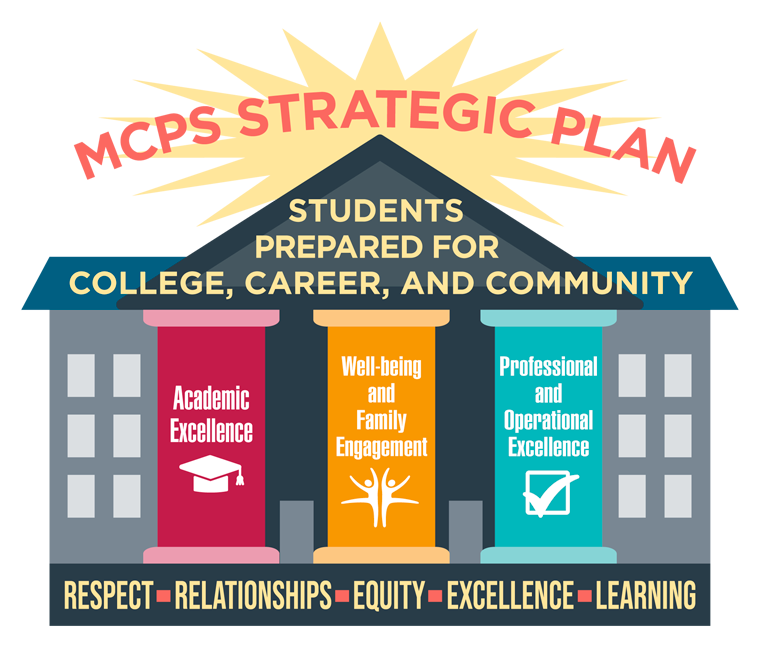Our Schools 2023-2024
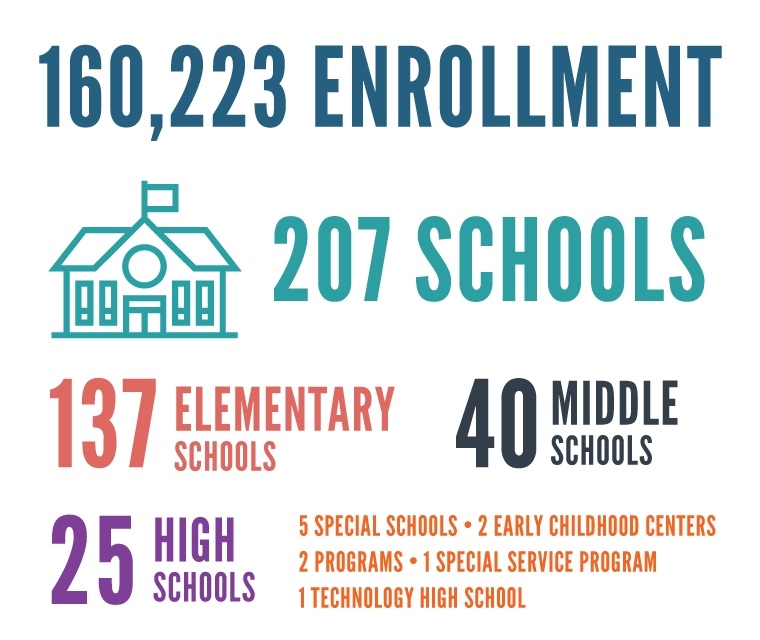
Student Demographics 2023-2024
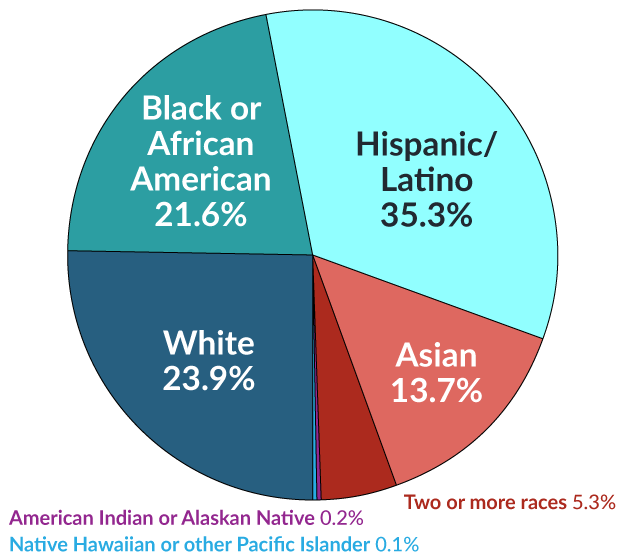
Graduation Rate 2022
2023 data coming in March 2024
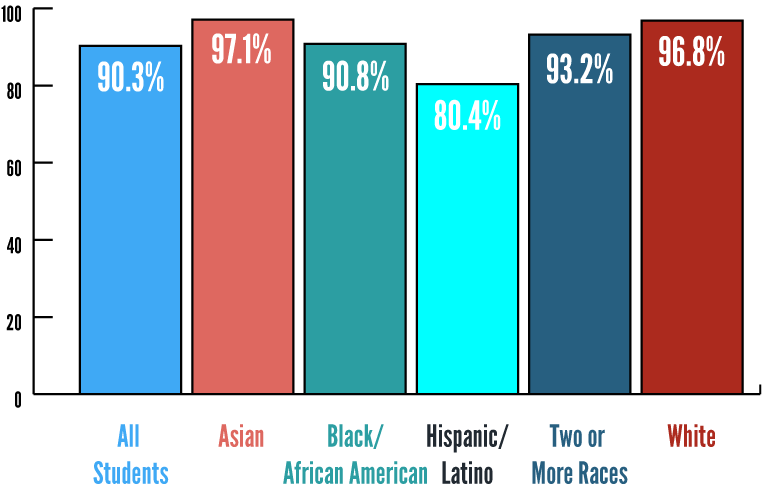
Services 2023-2024
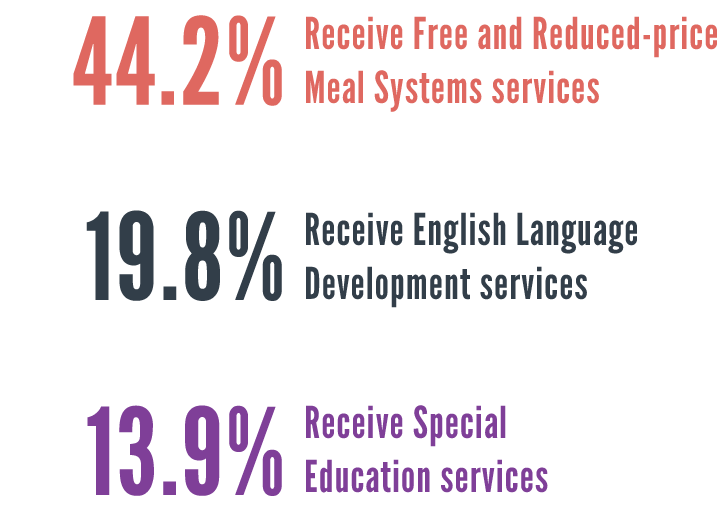
Every four years, the Montgomery County Board of Education (BOE) establishes a strategic plan to guide the work of Montgomery County Public Schools (MCPS).
Below you will find the objectives, targets and strategies organized into the three priority areas:
Academic Excellence
MCPS is committed to preparing all students for success in college, career and community. To do this, we must provide robust coursework, career opportunities and early access to college credit so students can be successful, whatever their path may be. MCPS will ensure that student outcomes are not predictable by race, ethnicity, socioeconomic status or educational need.
Improve student achievement in literacy and mathematics
Objective
Improve student achievement in literacy and mathematics
Strategies Identified for 2023-2024
- Provide professional learning and coaching to school-based staff in support of equitable, grade-level instruction in literacy and mathematics, aligned to the Maryland College and Career-Ready Standard or Alternate Maryland Academic Standards.
- Ongoing monitoring of data, for all students with an emphasis on Emergent Multilingual Learners (EMLs) and students receiving special education services, to determine whether students are making progress in literacy and mathematics and use results to support schools in alignment with the School Improvement Plan; inform development of curricular resources; and inform coaching around data-driven instructional planning at the school level.
- Provide professional development, coaching and curriculum development to ensure all students with an emphasis on EMLs and students receiving special education services are receiving differentiated instruction at grade-level standards aligned to the Maryland College and Career-Ready Standards or Alternate Maryland Academic Standards, with appropriate scaffolds, supports and accommodations.
Metrics of Success
| Metrics of Success | Baseline (2020-2021) |
Year 1 ACTUAL (2021-2022) |
Year 2 TARGET (2022-2023) |
Year 2 ACTUAL (2022-2023) |
Year 3 TARGET(2023-2024) |
Year 4 TARGET (2024-2025) |
|---|---|---|---|---|---|---|
| % of students meeting Evidence of Learning Literacy | 57.9% | 71.7% | 73.9% | 73.4% | 81.9% | 90.0% |
| % of students meeting Evidence of Learning Mathematics | 55.4% | 61.2% | 72.7% | 61.3% | 81.4% | 90.0% |
| Equity Accountability Model: Academic Achievement Component Overall Score: Literacy Mathematics |
1.8 1.5 |
2.2 1.5 |
2.0 2.2 |
2.4 1.6 |
2.3 2.4 |
2.6 2.6 |
| Equity Accountability Model: Students With Disabilities Component Overall Score: Literacy Mathematics |
1.0 1.0 |
1.0 1.0 |
1.8 1.8 |
2.0 1.0 |
2.2 2.2 |
2.6 2.6 |
BOE Presentation
- BOE Business Meeting: December 5, 2023
- BOE Business Meeting: November 9, 2023
- BOE Business Meeting: October 26, 2023
- BOE Business Meeting: October 12, 2023
- BOE Business Meeting: September 21, 2023
- BOE Business Meeting: September 7, 2023
- BOE Business Meeting: August 24, 2023
- BOE Business Meeting: July 20, 2023
- BOE Business Meeting: April 20, 2023
- BOE Business Meeting: March 28, 2023
- Budget Work Session: Feb. 9, 2023
- BOE Business Meeting: Sept. 22, 2022
Increase the percentage of students graduating high school
Objective
Increase the percentage of students graduating high school
Strategies Identified for 2023-2024
- Transition planning and progress monitoring for high school students nearing graduation will include check-in meetings with Grade 11 students receiving special education services and Emergent Multilingual Learners, including students with international credits.
- Ongoing monitoring of high school graduation plans and requirements for each prospective graduate and senior check-in meetings to monitor student performance towards graduation and post-secondary plans.
- A Central Office team will monitor student graduation requirements through quarterly meetings with every high school’s administrative staff.
Metrics of Success
| Metrics of Success | Baseline (2020-2021) |
Year 1 ACTUAL (2021-2022) |
Year 2 TARGET (2022-2023) |
Year 2 ACTUAL (2022-2023) |
Year 3 TARGET(2023-2024) |
Year 4 TARGET (2024-2025) |
|---|---|---|---|---|---|---|
| Four-Year Graduation Rate | 89.3% | 90.3% (Class of 2022) |
92.13% | NYA |
93.57% | 95.0% |
| Five-Year Graduation Rate | 91.2% | 92.8% (Class of 2021) |
93.0% | NYA |
94.0% | 95.0% |
| Equity Accountability Model: Graduation Rate Component Overall Score | 2.8 | 2.4 | 3.0 | NYA |
3.0 | 3.0 |
BOE Presentation
Increase access to enriched and accelerated opportunities for underrepresented student groups
Objective
Increase access to enriched and accelerated opportunities for underrepresented student groups
Strategies Identified for 2023-2024
- Provide guidance and training to schools to review and identify students for enriched and/or accelerated courses through the use of multiple data points and criteria.
- Provide professional development to staff through an antiracist lens to:
- Monitor participation and progress of students in accelerated and enriched courses.
- Assist with gifted and talented identification and articulation.
- Ensure students with potential are provided access to advanced coursework and pathways, and meet the needs of students in accelerated and enriched courses with differentiated instruction.
Metrics of Success
| Metrics of Success | Baseline (2020-2021) |
Year 1 ACTUAL (2021-2022) |
Year 2 TARGET (2022-2023) |
Year 2 ACTUAL (2022-2023) |
Year 3 TARGET(2023-2024) |
Year 4 TARGET (2024-2025) |
|---|---|---|---|---|---|---|
| Number of Students Invited to Enroll in Enriched and Accelerated Programs and Courses: Elementary Schools | FARMS = 235 Spec Ed = 48 ESOL = 21 |
170 35 125 |
265 54 23 |
201 28 34 |
280 57 24 |
294 60 26 |
| Number of Students Invited to Enroll in Enriched and Accelerated Programs and Courses: Middle Schools | FARMS = 70 Spec Ed = 12 ESOL = 8 |
184 33 177 |
80 14 9 |
118 25 4 |
85 15 10 |
88 15 10 |
| Number of Students Invited to Enroll in Enriched and Accelerated Programs and Courses: High Schools | FARMS = 164 Spec Ed = 23 ESOL = 21 |
163 32 24 |
184 27 23 |
154 16 5 |
194 29 24 |
205 29 26 |
*Data represents students who are in centrally managed admission, criteria-based programs
BOE Presentation
Increase Maryland College and Career Readiness Rates
Objective
Increase Maryland College and Career Readiness Rates
Strategies Identified for 2023-2024
- Engage parents and guardians by offering workshops and resources in multiple languages to help them support their children's education at home.
- To aid understanding, use scaffolded approaches, such as visuals, graphic organizers and hands-on activities.
Metrics of Success
| Metrics of Success | Baseline (2020-2021) |
Year 1 ACTUAL (2021-2022) |
Year 2 TARGET (2022-2023) |
Year 2 ACTUAL (2022-2023) |
Year 3 TARGET(2023-2024) |
Year 4 TARGET (2024-2025) |
|---|---|---|---|---|---|---|
| Percent of Students Meeting Maryland College and Career Readiness Standards: Literacy | 89.3% | 85.6% | 94.7% | 53.2%* | Targets will be recalculated when MSDE finalizes CCR measures | Targets will be recalculated when MSDE finalizes CCR measures |
| Percent of Students Meeting Maryland College and Career Readiness Standards: Mathematics | 81.2% | 81.3% | 90.6% | 10.2%* | Targets will be recalculated when MSDE finalizes CCR measures | Targets will be recalculated when MSDE finalizes CCR measures |
*The College and Career Readiness results are based on interim measures calculated for Grade 10.
BOE Presentation
Improve completion rates to Career and Technical Education (CTE) programs
Objective
Improve completion rates to Career and Technical Education (CTE) programs
Strategies Identified for 2023-2024
- Increase students’ completion of CTE programs by:
- Providing ongoing professional learning on program articulation and requirements to counselors, teachers and administrators.
- Monitoring course completion and progression.
- Providing students academic support, when needed.
- Supporting attainment of Industry Recognized Credentials (IRC) and Technical Skills Assessments (TSA).
- Ensuring completion of capstone courses through internships or dual enrollment.
- Increase CTE program access for Emergent Multilingual Learners, students receiving special education services, and students economically impacted with targeted outreach to all stakeholders including guidance to families on how to request accommodations in CTE.
- Increase CTE program enrollment by increasing middle school awareness of CTE and Work-Based Learning options and providing support with the high school regional program application process.
Metrics of Success
| Metrics of Success | Baseline (2020-2021) |
Year 1 ACTUAL (2021-2022) |
Year 2 TARGET (2022-2023) |
Year 2 ACTUAL (2022-2023) |
Year 3 TARGET(2023-2024) |
Year 4 TARGET (2024-2025) |
|---|---|---|---|---|---|---|
| Percent of High School Students with CTE Program Completion or Earning Industry-Recognized Credentials | 19.9% | 12.2% | 32.5% | 15.9% | 38.8% | 45.0% |
BOE Presentation
Increase postsecondary education enrollment
Objective
Increase postsecondary education enrollment
Strategies Identified for 2023-2024
- Provide high school students with opportunities to visit college campuses.
- Increase opportunities for students in grades 8-12 to participate in college and career fair opportunities, use Naviance for college and career planning, and expand dual-enrollment awareness to increase exposure to postsecondary pathways.
Metrics of Success
| Metrics of Success | Baseline (2020-2021) |
Year 1 ACTUAL (2021-2022) |
Year 2 TARGET (2022-2023) |
Year 2 ACTUAL (2022-2023) |
Year 3 TARGET(2023-2024) |
Year 4 TARGET (2024-2025) |
|---|---|---|---|---|---|---|
| Percent of Graduating Class Enrolling in Postsecondary School 12 months post high school | 72.3% (Class of 2019) |
65.3% (Class of 2021) |
73.2% | 66.5% (Class of 2022) |
74.1% | 75% |
BOE Presentation
Increase career training opportunities for all students
Objective
Increase career training opportunities for all students
Strategies Identified for 2023-2024
- Increase student participation in Work-Based Learning (WBL) programs by developing action plans to structure and guide each school’s recruitment priorities and program awareness.
- Provide ongoing professional learning opportunities for internship coordinators and counselors to build capacity in curriculum implementation and community partnerships.
- Increase school and community awareness of WBL programs and opportunities through regular, centralized messaging from schools and the district, including clarity on the MCPS website.
Metrics of Success
| Metrics of Success | Baseline (2020-2021) |
Year 1 ACTUAL (2021-2022) |
Year 2 TARGET (2022-2023) |
Year 2 ACTUAL (2022-2023) |
Year 3 TARGET(2023-2024) |
Year 4 TARGET (2024-2025) |
|---|---|---|---|---|---|---|
| Percent of Graduating Class Accessing Work-based Learning | 14.8% | 19% | 30% | 30% | 37.6% | 45% |
BOE Presentation
Well-Being and Family Engagement
Well-being and family engagement is an important part of student success. A critical component is supporting staff and students’ social-emotional needs so that everyone is thriving emotionally and academically. Just as important for success is MCPS' commitment to culturally responsive communication that provides all families the information, access and relationships needed to support their children.
Promote positive, caring and supportive district and school climates respectful of students and staff
Objective
Promote positive, caring and supportive district and school climates respectful of students and staff
Strategies Identified for 2023-2024
- In partnership with the Jed Foundation—a national nonprofit dedicated to protecting emotional health and preventing suicide among youth—MCPS will engage in a three-year cohort to develop a data-driven, integrated, districtwide mental health framework for ongoing progress monitoring, assessment and enhancement of mental health and well-being programs and services.
- Increase the number of Study Circle facilitators through targeted professional learning for school-based staff.
- Provide schools with professional training and resources to enable them to implement student well-being best practices related to referrals, root cause analysis and targeted interventions, and to document those interventions.
- Regularly schedule attendance data monitoring meetings at the school and central office levels.
Metrics of Success
| Metrics of Success | Baseline (2020-2021) |
Year 1 ACTUAL (2021-2022) |
Year 2 TARGET (2022-2023) |
Year 2 ACTUAL (2022-2023) |
Year 3 TARGET(2023-2024) |
Year 4 TARGET (2024-2025) |
|---|---|---|---|---|---|---|
| Family, Student and Staff Feedback Surveys Response Rate | New | NYA | No Target Set | Staff: 40.3% Family: NYA Student: NYA |
NYA | NYA |
| Percent Completion of District-Provided Training for Students and Staff to Promote a Positive School Culture: Students | 52% | 25% | 76% | 26% | 88% | 100% |
| Percent Completion of District-provided Training for Students and Staff to Promote a Positive School Culture: Staff | New | In Development | In Development | In Development | ||
District-provided Health and Wellness Programs for Students and Staff
|
New | 4,969 17,047 3,848 |
N/A 20,000 N/A |
4,197 21,883 3,015 |
N/A 23,000 N/A |
N/A 26,000 N/A |
BOE Presentation
Implement school-level practices to support effective and efficient behavioral health management systems
Objective
Implement school-level practices to support effective and efficient behavioral health management systems
Strategies Identified for 2023-2024
- Develop skills and support for restorative justice coaches through Professional Learning Communities and extend training opportunities for other restorative practitioners, including well-being social workers, wellness coaches and community partners.
- Create and implement targeted action plans to address disproportionality of suspensions of Black/African American students for 20 Focus schools, co-led by a restorative justice instructional specialist and local restorative justice coaches that include monthly team data analysis, walk-throughs with reflections, targeted professional development and support meetings.
- Continue to use the Comprehensive Coordinated Early Intervening Services Plan to review and address disproportionate suspensions of Black and Latino students with individualized education programs.
- Create and engage a parent and community stakeholder committee and Restorative Justice Student and Suspension Action Group to review suspension data and provide feedback about the actions taken as measured by current state and district policies. Feedback will be shared with school leaders. The committees will also participate in a policy review and provide recommendations for the Student Code of Conduct.
- Engage in monthly data analysis and professional learning with principal supervisors.
Metrics of Success
| Metrics of Success | Baseline (2020-2021) |
Year 1 ACTUAL (2021-2022) |
Year 2 TARGET (2022-2023) |
Year 2 ACTUAL (2022-2023) |
Year 3 TARGET(2023-2024) |
Year 4 TARGET (2024-2025) |
|---|---|---|---|---|---|---|
| Percent of Schools Implementing Restorative Practices | 20% | 67.4% | 60% | 90% | 80% | 100% |
| Percent of Schools Implementing Social-Emotional Curricula | New | 37.9% | 59% | 69% | 79% | 100% |
| Percent of Office Referrals for Disrespect, Disruption and Insubordination for Black or African American and Hispanic/Latino Students | 64.4% (2019-2020) |
78.3% | 59.6% | 76.3% | 54.8% | 50% |
| Percent of Out-of-School Suspensions for Disrespect, Disruption and Insubordination for Black or African American and Hispanic/Latino Students | 79.6% (2019-2020) |
83.1% | 69.7% | 76.8% | 59.8% | 50% |
BOE Presentation
Implement culturally responsive family engagement that promotes two-way communication and empowers families to be partners with MCPS
Objective
Implement culturally responsive family engagement that promotes two-way communication and empowers families to be partners with MCPS
Strategies Identified for 2023-2024
- Train schools on the Antiracist and Culturally Responsive Family Engagement module for School Improvement.
- Develop a menu of professional learning opportunities for schools, which will foster environments where families feel safe, valued and heard.
- Implement school-specific and cluster-specific parent workshops based on needs assessments with communities.
- Develop a tool to help schools monitor adoption and usage of ParentVUE.
- Implement Remind 101, a districtwide, two-way communication tool.
Metrics of Success
| Metrics of Success | Baseline (2020-2021) |
Year 1 ACTUAL (2021-2022) |
Year 2 TARGET (2022-2023) |
Year 2 ACTUAL (2022-2023) |
Year 3 TARGET(2023-2024) |
Year 4 TARGET (2024-2025) |
|---|---|---|---|---|---|---|
| Number of Family Workshops (i.e. Parent Academy, Study Circles) and Community Outreach Events | 67 | 75 | 73 | 69 (Parent Academy sessions) |
76 | 80 |
| Percent of Families with ParentVue Activations | 62% | 79% | 81% | 84.4% | 90.5% | 100% |
Innovative Communications Strategies Used to Reach Families
| New | Over 3,000 families reached; 24 pop-up events | Over 5,000 families; 30 pop-up events | Over 6,000 families reached; 30 pop-up events | Over 7,000 families reached: 40 pop-up events | Over 8,000 families reached: 50 pop-up events |
BOE Presentation
Professional and Operational Excellence
Student success is only possible by hiring and maintaining a highly qualified, diverse and culturally proficient workforce. MCPS will use targeted recruitment strategies, teacher pathway programs for our supporting services staff and regular professional development to ensure we have the best educators. Our commitment to effective operations across the district allows schools to maintain their focus on student success. This includes direct support to schools and students’ equal access to resources, stable financial practices and a commitment to environmental protection.
Increase districtwide, culturally relevant professional learning for all staff to support equity and to increase capacity for teaching
Objective
Increase districtwide, culturally relevant professional learning for all staff to support equity and to increase capacity for teaching
Strategies Identified for 2023-2024
- Mandatory training for all leaders and instructional specialists focused on coherence, accountability, equity-centered capacity building and relational trust.
- Development and implementation of the new equitable teaching and learning framework.
- Development of an enhanced evaluation process for professional learning to gauge participant satisfaction and effectiveness of implementation.
Metrics of Success
| Metrics of Success | Baseline (2020-2021) |
Year 1 ACTUAL (2021-2022) |
Year 2 TARGET (2022-2023) |
Year 2 ACTUAL (2022-2023) |
Year 3 TARGET(2023-2024) |
Year 4 TARGET (2024-2025) |
|---|---|---|---|---|---|---|
| Number of Teachers and School Leaders Completing District Professional Development Focused on Instructional Strategies | 12,635 | 15,080 | 13,899 | 11,981 | 14,531 | 15,162 |
| Percent Completion of Professional Learning Courses Offered for New Teachers (New Teacher Training) | 92% | 82% | 96% | 83% | 98% | 100% |
| Staff Participating in Culturally Relevant Community Engagement Professional Development Opportunity in Identified Community Schools | New | 503 | 515 | 690 | 795 | 1000 |
BOE Presentation
Increase professional learning opportunities for teachers and staff in trauma-informed practices to support students' social-emotional well-being
Objective
Increase professional learning opportunities for teachers and staff in trauma-informed practices to support students' social-emotional well-being
Strategies Identified for 2023-2024
- Learning and achievement specialists will coach staff development teachers and prioritized leadership teams to provide consistent coaching and feedback to staff around implementation of the professional learning plan.
- Mental health coordinators will develop additional professional development opportunities focused on trauma-informed practices for school staff. This will include collaboration with outside agencies to support staff training.
Metrics of Success
| Metrics of Success | Baseline (2020-2021) |
Year 1 actual (2021-2022) | Year 2 TARGET (2022-2023) |
Year 2 ACTUAL (2022-2023) |
Year 3 TARGET(2023-2024) |
Year 4 TARGET (2024-2025) |
|---|---|---|---|---|---|---|
| Number of Professional Development Courses Offered Focused on Trauma-Informed Practices | New | 2 | 3 | 2 | 4 | 5 |
| Number of Staff Completing Professional Development Courses Focused on Trauma-Informed Practices | New | 90 | 180 | 183 | 270 | 360 |
BOE Presentation
Improve the strategic recruitment strategy in order to increase high-quality workforce diversity
Objective
Improve the strategic recruitment strategy in order to increase high-quality workforce diversity
Strategies Identified for 2023-2024
- Provide scholarships to recent graduates and stipends to teachers mentoring graduates pursuing careers in education.
- Recruit eligible students and recent graduates through school-based career events for temporary part-time and permanent positions in MCPS.
- Improve student-teacher placement experience to include the accelerated application process.
- Create professional development opportunities for interns that include the application process and best interview practices.
- Continue to serve on educational preparation work groups with the Hispanic-Serving Institutions (HSI) and Historically Black Colleges and Universities (HBCU).
Metrics of Success
| Metrics of Success | Baseline (2020-2021) |
Year 1 ACTUAL (2021-2022) |
Year 2 TARGET (2022-2023) |
Year 2 ACTUAL (2022-2023) |
Year 3 TARGET(2023-2024) |
Year 4 TARGET (2024-2025) |
|---|---|---|---|---|---|---|
| Job Fairs Attended for Recruitment of High-Quality and Diverse Candidates | 13 | 35 | 14 | 44 | 15 | 16 |
| Professional Workforce Diversity Rates American Indian or Alaskan Native |
0.2% 8.8% 18.4% 14.5% 0.1% 1.5% 56.4% |
0.2% 9% 18.4% 15.2% 0.1% 1.5% 55.7% |
N/A | 0.2% 9.5% 18.9% 16.3% 0.1% 1.4% 53.6% |
N/A | N/A |
BOE Presentation
Improve connectivity and satisfaction with MCPS technology
Objective
Improve connectivity and satisfaction with MCPS technology
Updated Strategies for 2022-2023
- Use grant funding to continue to provide a limited amount of hot spots to families.
- Examine current learning technology platforms and develop opportunities for more coherence and streamlined processes, while creating cost savings.
- Examine and review survey responses to make improvements to technology platforms/resources, including consolidating platforms to ensure technology is beneficial and accessible to families.
Metrics of Success
| Metrics of Success | Baseline (2020-2021) |
Year 1 ACTUAL (2021-2022) |
Year 2 TARGET (2022-2023) |
Year 2 ACTUAL (2022-2023) |
Year 3 TARGET(2023-2024) |
Year 4 TARGET (2024-2025) |
|---|---|---|---|---|---|---|
| Technology Survey on Applications and Platforms Used Across Schools | New | 68% | 75% | 83% | 82% | 90% |
| Staff, Student, and Family Surveys of Technology Use and Connectivity | New | 98% | 99% | 99.3% | 99.5% | 100% |
BOE Presentation
Improve the strategic recruitment strategy to support the social-emotional well-being of all students
Objective
Improve the strategic recruitment strategy to support the social-emotional well-being of all students
Strategies Identified for 2023-2024
- Partner with organizations, such as the National Association of State Boards of Education (NASBE), the National Association of School Psychologists (NASP), Hispanic-Serving Institutions (HSI) and Historically Black Colleges and Universities (HBCUs), to create recruitment events targeting diverse mental health professionals.
- Collaborate with academic institutions that have mental health programs and serve minority communities to create internship and practicum placement opportunities. These programs may include: HSI, Asian American and Native American Pacific Islander-Serving Institutions (AANAPISI), and HBCUs.
- Advertise job openings on a variety of platforms and job boards, such as NASP, the American School Counselor Association (ASCA) and the National Association of Social Workers (NASW).
Metrics of Success
| Metrics of Success | Baseline (2020-2021) |
Year 1 ACTUAL (2021-2022) |
Year 2 TARGET (2022-2023) |
Year 2 ACTUAL (2022-2023) |
Year 3 TARGET(2023-2024) |
Year 4 TARGET (2024-2025) |
|---|---|---|---|---|---|---|
| Job Fairs Attended for Recruitment of Psychologists and Counselors | New | 2 | 2 | 2 | 3 | 4 |
| Number of Psychologists and Counselors Hired | New | 70 (61 Counselors 9 Psychologists) |
N/A | 58 (51 Counselors 7 Psychologists) |
N/A | N/A |
BOE Presentation
Connect the district’s financial plan to the strategic plan with the goal of aligning all district resources and increase transparency
Objective
Connect the district’s financial plan to the strategic plan with the goal of aligning all district resources and increase transparency
Strategies Identified for 2023-2024
- Develop and produce a program budget that aligns with key programs and the strategic plan.
- Develop a balanced budget that allows for the highest priority accelerators based on staff and stakeholder input.
- Develop a budget dashboard to provide increased clarity and understanding of budget allocations and resources.
Metrics of Success
| Metrics of Success | Baseline (2020-2021) |
Year 1 ACTUAL (2021-2022) |
Year 2 TARGET (2022-2023) |
Year 2 ACTUAL (2022-2023) |
Year 3 TARGET(2023-2024) |
Year 4 TARGET (2024-2025) |
|---|---|---|---|---|---|---|
| Total Number of Professional Development Courses Offered to Learning MCPS Business Hub (includes synchronous and asynchronous)* | New | 14 | 16 | 14 | No Target Set | No Target Set |
| Number of staff completing at least one professional development course to learn the MCPS Business Hub | New | 690 | 600 | 533 | No Target Set | No Target Set |
BOE Presentation
Continue to provide and maintain safe and clean facilities that ensure accessibility and support the learning environment
Objective
Continue to provide and maintain safe and clean facilities that ensure accessibility and support the learning environment
Strategies Identified for 2023-2024
- Provide professional learning for all Division of Maintenance and Operations staff and increase workforce capacity.
- Configure Asset Essential (AE) to ensure preventative maintenance orders are closed within 30 days.
- Monitor the custodial supplies accounts and provide support to building service managers.
- Restructure second shift facilities improvement team (FIT) in order to create more efficient processes.
- Develop and pilot a centralized grounds care program.
- Support and continue the preventative maintenance (PM) program by expanding professional learning.
Metrics of Success
| Metrics of Success | Baseline (2020-2021) |
Year 1 ACTUAL (2021-2022) |
Year 2 TARGET (2022-2023) |
Year 2 ACTUAL (2022-2023) |
Year 3 TARGET(2023-2024) |
Year 4 TARGET (2024-2025) |
|---|---|---|---|---|---|---|
| Percent of Received Maintenance Work Orders Completed | 96.1% | 83.2% | 97.9% | 93.81% | 98.8% | 100% |
| Percent of Buildings Meeting 'Adequate Rating' on State Assessment | 86% | 94.6% | 93% | 95.5% | 96.5% | 100% |
| Percent of Schools and Offices Completing Emergency Preparedness Activities | 25.8% (Schools Only: 2019-2020) |
88.7% | 63% | 92% | 81.6% | 100% |
BOE Presentation
Increase experienced and diverse principals and teachers serving in high-need schools
Objective
Increase experienced and diverse principals and teachers serving in high-need schools
Strategies Identified for 2023-2024
- Implement the second year of a grant-based program in partnership with the The New Teacher Project, which works to build a leadership network of diverse principals and teachers.
- Develop and implement an incentive plan to attract and retain principals and teachers in high-needs schools.
- Provide job-embedded support and coaching for principals and teachers after they are hired.
- Hold monthly and quarterly meet-and-greets and information sessions with internal and external aspiring and experienced diverse candidates to attract them to highly impacted schools.
- Partner with local and national affinity groups and organizations that support diverse educators to increase the principal pipeline.
Metrics of Success
| Metrics of Success | Baseline (2020-2021) |
Year 1 ACTUAL (2021-2022) |
Year 2 TARGET (2022-2023) |
Year 2 ACTUAL (2022-2023) |
Year 3 TARGET(2023-2024) |
Year 4 TARGET (2024-2025) |
|---|---|---|---|---|---|---|
| Percentage of experienced principals in high-needs schools | New | ES: 60% MS: 60% HS: 64% |
ES: 65% MS: 65% HS: 70% |
ES: 83% MS: 57% HS: 79% |
ES: 70% MS: 70% HS: 76% |
ES: 75% MS: 75% HS: 82% |
| Percentage of experienced teachers in high needs schools | New | ES: 80% MS: 76% HS: 84% |
ES: 85% MS: 81% HS: 91% |
ES: 89% MS: 84% HS: 92% |
ES: 90% MS: 86% HS: 96% |
ES: 95% MS: 91% HS: 96% |
| Number of principals and teachers that received job-embedded support | New | 38 principals 627 teachers |
No Target Set | 39 principals 639 teachers |
No Target Set | No Target Set |
*Experienced is defined as having 3+ years working as a principal or teacher.
